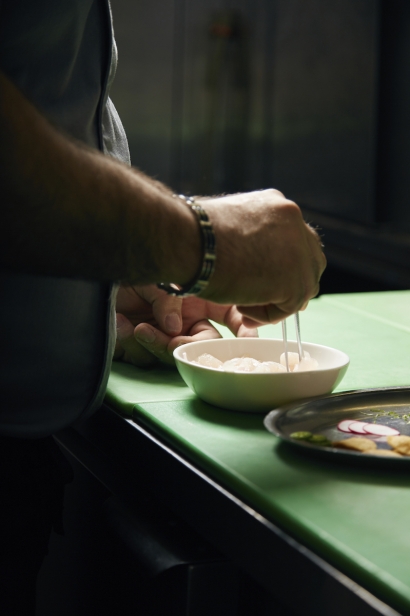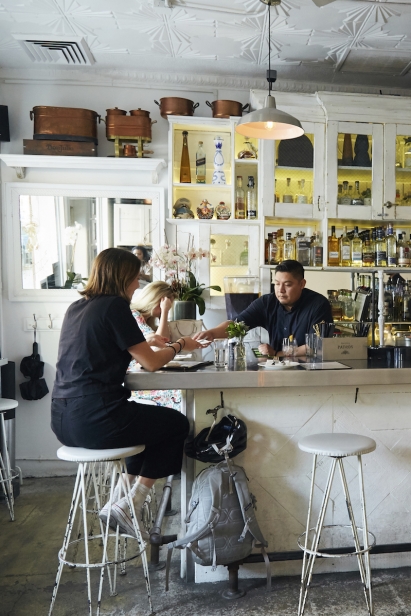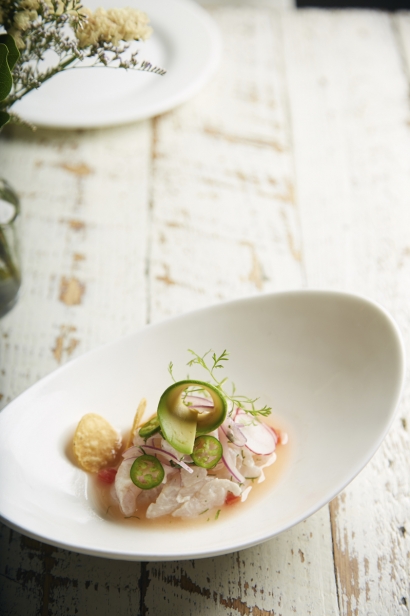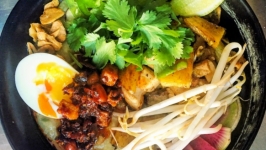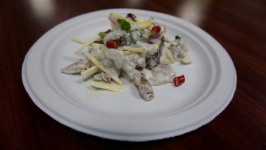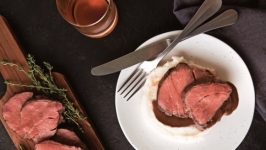Estrella Naciente: How Chef Cosme Aguilar became a rising star—and earned one from Michelin
Queens, a borough famous for its authentic approximations of dishes from across the globe—in Astoria’s Greek tavernas, Flushing’s food malls and Little Tibet’s momo counters—it remains difficult to find serious mole or a quality tortilla.
Chef Cosme Aguilar has taken it upon himself to fill this gap, not only creating serious Mexican food, but earning a Michelin star in the process.
There’s an inherent tension with the city’s, and the entire country’s, relationship with Mexican food. Although Tex-Mex reigns in the Southwest, and Californians take pride in the state’s ubiquitous taquerias, what most of us know as Tierra Azteca’s “authentic” cuisine is dumbed down, and a genre all its own—certainly not authentic Mexican. Generally, Mexican food in the United States ditches regionality and coddles the American palate with rich, exaggerated approximations. It relies on our population’s preference for all things fried and calorically extravagant.
Understandably, this frustrates Aguilar. “It makes me mad when I go to a Mexican restaurant and they make me something that’s not good,” he says. “They lose the way we cook [in Mexico]. We don’t put lettuce in tacos. We don’t add cream. They’ve adapted to American taste preferences.”
It’s late summer and we’re seated at a small table outside the restaurant’s basement kitchen, where the boss does his paperwork.
Aguilar explains his mission to bring real Mexican cuisine to New York. “When we opened Casa Enrique I said, ‘I’m going to cook for Mexicans. And people who appreciate Mexican food. I don’t want to cook for people who want to come and have a burrito or nachos. It’s not my type of food. I don’t want to lose the authenticity.”
Aguilar grew up in Chiapas, and emigrated from Mexico in 1998. “Like everybody, I was broke. And I came to the States to have a better life.” Before leaving Mexico, he lived in Puebla and Mexico City, and thus, his restaurant transcends regional focus for a wider, national approach to the country’s cuisine. Aguilar followed his brother Luis (who declined to be interviewed for this story), to Café Henri. From porter, to prep cook, to sous, he worked his way up the ranks. Fourteen years later, they opened Casa Enrique together; Luis is the manager and mixologist, and the elder Aguilar, the chef.
Despite his purely Mexican upbringing, and his distaste for America’s Mexican food, Aguilar contends that authenticity is derived from the ingredients employed, and the observance of traditions, rather than a cook’s background. Alongside Mexican Americans, Aguilar’s kitchen staff of roughly 20 is made up of Colombians, Ecuadorians, Peruvians and a Haitian.
He recalls,“When I was cooking French, and someone would come into the restaurant and say ‘Oh, a Mexican is cooking French? I don’t think so.’ I [would think] ‘OK, so try my food.’ I wasn’t born in France, but I was trained in French.”
Proper training inspires accuracy. He adds, “If you know how to cook, and someone has taught you well, I don’t see why you can’t cook something else besides your country’s [cuisine]. You know, Alex Stupak of Empellon is cooking Mexican. He’s American and he is very good. He cooks whatever he likes.”
Aguilar isn’t sure why it’s so hard to find his home country’s best dishes stateside. But, he reasons that if the problem is going to change, those preparing Mexican food must ditch the reliably uniform for creativity. “I don’t cook it the way you want it; I cook it the way I want it,” he says. “I use Mexican ingredients to cook my way.”,” he says.
It’s hard to imagine an Italian chef in Italy concerned with making their pastas or pizzas purely Italian. Rather, comfort within one’s given cuisine, and the ability to take the awareness of tradition for granted, allows a chef to inhabit his or her unique place within a culinary moment—true authenticity.
This method won Aguilar his first Michelin star in 2014. But the star adds pressure. “It hasn’t been the same. Before, I was cooking for the neighborhood. I wasn’t thinking about outsiders from other countries. … If you go to a Michelin-star restaurant you expect it to be better, so I had to be better. Every day we have to try to be better and better without losing what we started.”
Aguilar’s commitment to continuous improvement extends beyond the kitchen. Omar Castillo, Casa Enrique’s manager, and Aguilar’s former roommate and best friend for 17 years, says, “As you know, he’s a Michelin-star chef. But, if anything breaks, he [fixes] it.”
Aguilar practically refuses to leave his restaurant. He says, “I have one day off and it’s not fun. I have to be honest, I don’t enjoy my time off. I’d rather be here than at my house.”
Perhaps this is because Casa Enrique is more of a home for Aguilar than his apartment nearby. With family and friends running the place, it’s no surprise. Castillo says, “You know, you always want to be with your friends. I get to be with my friends while I’m working. That’s the best part.”
I feel this familiarity as I’m served ceviche with lime juice and a sprinkling of serrano peppers. Aguilar has made his way upstairs to the bar to chat with customers. The chef appears clearly at home.
Chef Cosme Aguilar | @chefcosme
Casa Enrique | @casaenriquelic
Café Henri | @cafehenrilic



